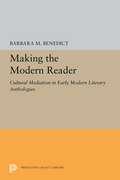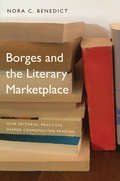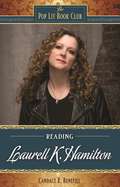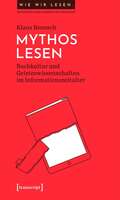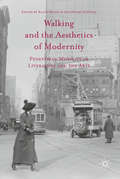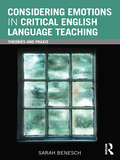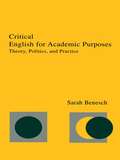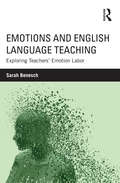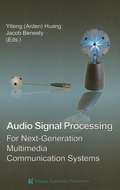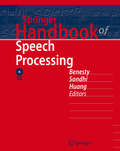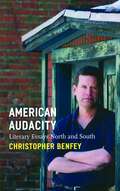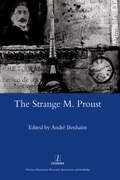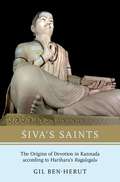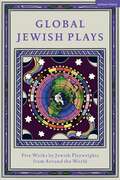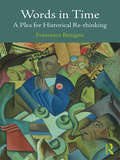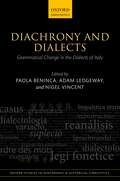- Table View
- List View
Making the Modern Reader: Cultural Mediation in Early Modern Literary Anthologies (Princeton Legacy Library #5235)
by Barbara M. BenedictInquiring into the formation of a literary canon during the Restoration and the eighteenth century, Barbara Benedict poses the question, "Do anthologies reflect or shape contemporary literary taste?" She finds that there was a cultural dialectic at work: miscellanies and anthologies transmitted particular tastes while in turn being influenced by the larger culture they helped to create. Benedict reveals how anthologies of the time often created a consensus of literary and aesthetic values by providing a bridge between the tastes of authors, editors, printers, booksellers, and readers.Making the Modern Reader, the first full treatment of the early modern anthology, is in part a history of the London printing trade as well as of the professionalization of criticism. Benedict thoroughly documents the historical redefinition of the reader: once a member of a communal literary culture, the reader became private and introspective, morally and culturally shaped by choices in reading. She argues that eighteenth-century collections promised the reader that culture could be acquired through the absorption of literary values. This process of cultural education appealed to a middle class seeking to become discriminating consumers of art.By addressing this neglected genre, Benedict contributes a new perspective on the tension between popular and high culture, between the common reader and the elite. This book will interest scholars working in cultural studies and those studying noncanonical texts as well as eighteenth-century literature in general.Originally published in 1996.The Princeton Legacy Library uses the latest print-on-demand technology to again make available previously out-of-print books from the distinguished backlist of Princeton University Press. These editions preserve the original texts of these important books while presenting them in durable paperback and hardcover editions. The goal of the Princeton Legacy Library is to vastly increase access to the rich scholarly heritage found in the thousands of books published by Princeton University Press since its founding in 1905.
Borges and the Literary Marketplace: How Editorial Practices Shaped Cosmopolitan Reading
by Nora C. BenedictA fascinating history of Jorge Luis Borges’s efforts to revolutionize and revitalize literature in Latin America Jorge Luis Borges (1899–1986) stands out as one of the most widely regarded and inventive authors in world literature. Yet the details of his employment history throughout the early part of the twentieth century, which foreground his efforts to develop a worldly reading public, have received scant critical attention. From librarian and cataloguer to editor and publisher, this writer emerges as entrenched in the physical minutiae and social implications of the international book world. Drawing on years of archival research coupled with bibliographical analysis, this book explains how Borges’s more general involvement in the publishing industry influenced not only his formation as a writer, but also global book markets and reading practices in world literature. In this way it tells the story of Borges’s profound efforts to revolutionize and revitalize literature in Latin America through his varying jobs in the publishing industry.
The Haiti Exception: Anthropology and the Predicament of Narrative (Francophone Postcolonial Studies #7)
by Alessandra Benedicty-Kokken Kaiama L. Glover Mark Schuller Jhon Picard ByronThis collection of essays considers the means and extent of Haiti’s ‘exceptionalization’ – its perception in multiple arenas as definitively unique with respect not only to the countries of the North Atlantic, but also to the rest of the Americas. Painted as repulsive and attractive, abject and resilient, singular and exemplary, Haiti has long been framed discursively by an extraordinary epistemological ambivalence. This nation has served at once as cautionary tale, model for humanitarian aid and development projects and point of origin for general theorising of the so-called Third World. What to make of this dialectic of exemplarity and alterity? How to pull apart this multivalent narrative in order to examine its constituent parts? Conscientiously gesturing to James Clifford’s The Predicament of Culture (1988), the contributors to The Haiti Exception work on the edge of multiple disciplines, notably that of anthropology, to take up these and other such questions from a variety of methodological and disciplinary perspectives, including Africana Studies, Anthrohistory, Art History, Black Studies, Caribbean Studies, education, ethnology, Jewish Studies, Literary Studies, Performance Studies and Urban Studies. As contributors revise and interrogate their respective praxes, they accept the challenge of thinking about the particular stakes of and motivations for their own commitment to Haiti.
Reading Laurell K. Hamilton (The Pop Lit Book Club)
by Candace R. BenefielThis exploration of author Laurell K. Hamilton's work examines the many novels of her series and shows how her writing has been a major influence on contemporary visions of the vampire—an ideal reference text for book club leaders.Long before Twilight achieved epic levels of popularity, Laurell K. Hamilton was reshaping the image of the vampire with her own take on the vampire mythos in her Anita Blake, Vampire Hunter fantasy novel series. While Hamilton's work draws on traditional vampire and fairy lore, her interpretation of these subjects brought new dimensions to the genres, influencing the direction of urban fantasy over the past two decades.Reading Laurell K. Hamilton focuses upon Hamilton's two bestselling series, the Anita Blake, Vampire Hunter series and the Merry Gentry series. The volume is intended as a resource for leaders of book clubs or discussion groups, containing chapters that examine Hamilton's role in the current vampire literature craze, the themes and characters in her work, and responses to Hamilton on the Internet. The book also provides a brief overview of Hamilton's life.
How to Speak Emoji
by Fred BenensonFor anyone who doesn’t know a smiley from a big red heart, a thumbs-up from a toilet symbol, a poo from two blonde girls dancing - this is the first book that will teach you HOW TO SPEAK EMOJI. With a collection of useful phrases and a handy dictionary to demonstrate what the emojis really mean, you’ll never feel out of your depth again - or make the embarrassing mistake of putting an aubergine symbol next to a peach.Including sections like: everyday greetings, in the workplace, in relationships and asking for help and directions, as well as how to translate song titles and film quotes, this is your complete guide to the bright new world of the emoji.
Mythos Lesen: Buchkultur und Geisteswissenschaften im Informationszeitalter (Wie wir lesen - Zur Geschichte, Praxis und Zukunft einer Kulturtechnik #2)
by Klaus BeneschDie Gründe für den rasanten Prestigeverlust von Buchkultur und Geisteswissenschaften sind vielfältig. Niemand weiß, wie die Zukunft des Lesens tatsächlich aussehen wird. Dennoch lassen sich einige Antworten aus den Entwicklungen seit der Jahrtausendwende extrapolieren. Um ein breites Spektrum unterschiedlicher Positionen zu Wort kommen zu lassen, nimmt Klaus Benesch das Thema nicht nur aus Sicht der Leseforschung und der Literaturwissenschaften in den Blick. Das Fragen nach der sich wandelnden Rolle des Lesens und der Geisteswissenschaften im Informationszeitalter verlangt auch nach der Ausweitung der Perspektive in den Bereich der Gesellschafts- und Wissenschaftspolitik. Neue Selbstbilder der Geisteswissenschaften sind nötig, die die Kulturtechnik des Lesens in Zeiten der Digitalisierung auf neuartige Weise zeitgemäß und nachhaltig erschließen.
Walking and the Aesthetics of Modernity: Pedestrian Mobility in Literature and the Arts
by Klaus Benesch François SpecqThis book gathers together an array of international scholars, critics, and artists concerned with the issue of walking as a theme in modern literature, philosophy, and the arts. Covering a wide array of authors and media from eighteenth-century fiction writers and travelers to contemporary film, digital art, and artists’ books, the essays collected here take a broad literary and cultural approach to the art of walking, which has received considerable interest due to the burgeoning field of mobility studies. Contributors demonstrate how walking, far from constituting a simplistic, naïve, or transparent cultural script, allows for complex visions and reinterpretations of a human’s relation to modernity, introducing us to a world of many different and changing realities.
Considering Emotions in Critical English Language Teaching: Theories and Praxis
by Sarah BeneschGroundbreaking in the ways it makes new connections among emotion, critical theory, and pedagogy, this book explores the role of students’ and teachers’ emotions in college instruction, illuminating key literacy and identity issues faced by immigrant students learning English in postsecondary institutions. Offering a rich blend of, and interplay between, theory and practice, it asks: How have emotions and affect been theorized from a critical perspective, and how might these theories be applied to English language teaching and learning? What do complex and shifting emotions, such as hope, disappointment, indignation, and compassion, have to do with English language teaching and learning in the neoliberal context in public universities? How might attention to emotions lead to deeper understanding of classroom interactions and more satisfying educational experiences for English language teachers and students? These questions are addressed not just theoretically, but also practically with examples from college classes of assigned readings, student writing, and classroom talk in which various emotions came into play. Thought-provoking, accessible, and useful, this is a must-read book for scholars, students, and teachers in the field of English language teaching.
Considering Emotions in Critical English Language Teaching: Theories and Praxis
by Sarah BeneschGroundbreaking in the ways it makes new connections among emotion, critical theory, and pedagogy, this book explores the role of students’ and teachers’ emotions in college instruction, illuminating key literacy and identity issues faced by immigrant students learning English in postsecondary institutions. Offering a rich blend of, and interplay between, theory and practice, it asks: How have emotions and affect been theorized from a critical perspective, and how might these theories be applied to English language teaching and learning? What do complex and shifting emotions, such as hope, disappointment, indignation, and compassion, have to do with English language teaching and learning in the neoliberal context in public universities? How might attention to emotions lead to deeper understanding of classroom interactions and more satisfying educational experiences for English language teachers and students? These questions are addressed not just theoretically, but also practically with examples from college classes of assigned readings, student writing, and classroom talk in which various emotions came into play. Thought-provoking, accessible, and useful, this is a must-read book for scholars, students, and teachers in the field of English language teaching.
Critical English for Academic Purposes: Theory, Politics, and Practice
by Sarah BeneschCritical English for Academic Purposes: Theory, Politics, and Practice is the first book to combine the theory and practice of two fields: English for academic purposes and critical pedagogy. English for academic purposes (EAP) grounds English language teaching in the cognitive and linguistic demands of academic situations, tailoring instruction to specific rather than general purposes. Critical pedagogy acknowledges students' and teachers' subject-positions, that is, their class, race, gender, and ethnicity, and encourages them to question the status quo. Critical English for academic purposes engages students in the types of activities they are asked to carry out in academic classes while inviting them to question and, in some cases, transform those activities, as well as the conditions from which they arose. It takes into account the real challenges non-native speakers of English face in their discipline-specific classes while viewing students as active participants who can help shape academic goals and assignments. Critical English for Academic Purposes: Theory, Politics, and Practice: * relates English for academic purposes and critical pedagogy, revealing and problematizing the assumptions of both fields, * provides theoretical and practical responses to academic syllabi and other institutional demands to show that teachers can both meet target demands and take students' subjectivities into account in a climate of negotiation and possibility, * offers "rights analysis" as a critical counterpart to needs analysis, * discusses the politics of "coverage" in lecture classes and proposes alternatives, and * features teaching examples that address balancing the curriculum for gender; building community in an EAP class of students from diverse economic and social backgrounds; students' rights; and organizing students to change unfavorable conditions. This book is intended for undergraduate and graduate courses for preservice and in-service ESL and EAP teachers. It is also a professional book for those interested in critical approaches to teaching and EAP.
Critical English for Academic Purposes: Theory, Politics, and Practice
by Sarah BeneschCritical English for Academic Purposes: Theory, Politics, and Practice is the first book to combine the theory and practice of two fields: English for academic purposes and critical pedagogy. English for academic purposes (EAP) grounds English language teaching in the cognitive and linguistic demands of academic situations, tailoring instruction to specific rather than general purposes. Critical pedagogy acknowledges students' and teachers' subject-positions, that is, their class, race, gender, and ethnicity, and encourages them to question the status quo. Critical English for academic purposes engages students in the types of activities they are asked to carry out in academic classes while inviting them to question and, in some cases, transform those activities, as well as the conditions from which they arose. It takes into account the real challenges non-native speakers of English face in their discipline-specific classes while viewing students as active participants who can help shape academic goals and assignments. Critical English for Academic Purposes: Theory, Politics, and Practice: * relates English for academic purposes and critical pedagogy, revealing and problematizing the assumptions of both fields, * provides theoretical and practical responses to academic syllabi and other institutional demands to show that teachers can both meet target demands and take students' subjectivities into account in a climate of negotiation and possibility, * offers "rights analysis" as a critical counterpart to needs analysis, * discusses the politics of "coverage" in lecture classes and proposes alternatives, and * features teaching examples that address balancing the curriculum for gender; building community in an EAP class of students from diverse economic and social backgrounds; students' rights; and organizing students to change unfavorable conditions. This book is intended for undergraduate and graduate courses for preservice and in-service ESL and EAP teachers. It is also a professional book for those interested in critical approaches to teaching and EAP.
Emotions and English Language Teaching: Exploring Teachers’ Emotion Labor
by Sarah BeneschTaking a critical approach that considers the role of power, and resistance to power, in teachers’ affective lives, Sarah Benesch examines the relationship between English language teaching and emotions in postsecondary classrooms. The exploration takes into account implicit feeling rules that may drive institutional expectations of teacher performance and affect teachers’ responses to and decisions about pedagogical matters. Based on interviews with postsecondary English language teachers, the book analyzes ways in which they negotiate tension—theorized as emotion labor—between feeling rules and teachers’ professional training and/or experience, in particularly challenging areas of teaching: high-stakes literacy testing; responding to student writing; plagiarism; and attendance. Discussion of this rich interview data offers an expanded and nuanced understanding of English language teaching, one positing teachers’ emotion labor as a framework for theorizing emotions critically and as a tool of teacher agency and resistance.
Emotions and English Language Teaching: Exploring Teachers’ Emotion Labor
by Sarah BeneschTaking a critical approach that considers the role of power, and resistance to power, in teachers’ affective lives, Sarah Benesch examines the relationship between English language teaching and emotions in postsecondary classrooms. The exploration takes into account implicit feeling rules that may drive institutional expectations of teacher performance and affect teachers’ responses to and decisions about pedagogical matters. Based on interviews with postsecondary English language teachers, the book analyzes ways in which they negotiate tension—theorized as emotion labor—between feeling rules and teachers’ professional training and/or experience, in particularly challenging areas of teaching: high-stakes literacy testing; responding to student writing; plagiarism; and attendance. Discussion of this rich interview data offers an expanded and nuanced understanding of English language teaching, one positing teachers’ emotion labor as a framework for theorizing emotions critically and as a tool of teacher agency and resistance.
Audio Signal Processing for Next-Generation Multimedia Communication Systems
by Jacob Benesty Yiteng Arden HuangAudio Signal Processing for Next-Generation Multimedia Communication Systems presents cutting-edge digital signal processing theory and implementation techniques for problems including speech acquisition and enhancement using microphone arrays, new adaptive filtering algorithms, multichannel acoustic echo cancellation, sound source tracking and separation, audio coding, and realistic sound stage reproduction. This book's focus is almost exclusively on the processing, transmission, and presentation of audio and acoustic signals in multimedia communications for telecollaboration where immersive acoustics will play a great role in the near future.
Springer Handbook of Speech Processing (Springer Handbooks)
by Jacob Benesty M. Mohan Sondhi Yiteng Arden HuangThis handbook plays a fundamental role in sustainable progress in speech research and development. With an accessible format and with accompanying DVD-Rom, it targets three categories of readers: graduate students, professors and active researchers in academia, and engineers in industry who need to understand or implement some specific algorithms for their speech-related products. It is a superb source of application-oriented, authoritative and comprehensive information about these technologies, this work combines the established knowledge derived from research in such fast evolving disciplines as Signal Processing and Communications, Acoustics, Computer Science and Linguistics.
American Audacity: Literary Essays North and South (Writers On Writing)
by Christopher BenfeyOne of the foremost critics in contemporary American letters, Christopher Benfey has long been known for his brilliant and incisive essays. Appearing in such publications as the New York Review of Books, the New Republic, and the Times Literary Supplement, Benfey's writings have helped us reimagine the American literary canon. In American Audacity, Benfey gathers his finest writings on eminent American authors (including Emerson, Dickinson, Whitman, Millay, Faulkner, Frost, and Welty), bringing to his subjects---as the New York Times Book Review has said of his earlier work---"a scholar's thoroughness, a critic's astuteness and a storyteller's sense of drama." Although Benfey's interests range from art to literature to social history, this collection focuses on particular American writers and the various ways in which an American identity and culture inform their work. Broken into three sections, "Northerners,""Southerners," and "The Union Reconsidered," American Audacity explores a variety of canonical works, old (Emerson, Dickinson, Millay, Whitman), modern (Faulkner, Dos Passos), and more contemporary (Gary Snyder, E. L. Doctorow). Christopher Benfey is the author of numerous highly regarded books, including Emily Dickinson: Lives of a Poet; The Double Life of Stephen Crane; Degas in New Orleans: Encounters in the Creole World of Kate Chopin and George Washington Cable; and, most recently, The Great Wave: Gilded Age Misfits, Japanese Eccentrics, and the Opening of Old Japan. Benfey's poems have appeared in the Paris Review, Pequod, and Ploughshares. He has held fellowships from the Guggenheim Foundation, the National Endowment for the Humanities, and the American Council of Learned Societies. Currently he is Mellon Professor of English at Mount Holyoke College. "In its vigorous and original criticism of American writers, Christopher Benfey's American Audacity displays its own audacities on every page." ---William H. Pritchard
The Strange M. Proust
by Andre BenhaimThe strange M. Proust - the narrator, the author, and the embodiment of A la Recherche du Temps perdu - is now so canonical a writer that his very strangeness is easily overlooked. His book made of other books, his epic composed of extraordinary miniatures, his orderly structure where every law is subverted, his chronology where time can be undone and his geography where places can superimpose: in these, and many other ways, Proust continues to astonish even readers who have engaged with him for their entire careers. In this book, arising from the Princeton symposium of 2006, major critics come together to offer provocative readings of a work which is at the same time classical and unusual, French and foreign, familiar and strange. The book is dedicated to the memory of Malcolm Bowie (1943-2007), whose keynote address was one of his last major lectures. Other contributors include David Ellison, Anne Simon, Eugene Nicole, Joseph Brami, Raymonde Coudert, Christie McDonald, Michael Wood and Antoine Compagnon.
The Strange M. Proust
by Andre BenhaimThe strange M. Proust - the narrator, the author, and the embodiment of A la Recherche du Temps perdu - is now so canonical a writer that his very strangeness is easily overlooked. His book made of other books, his epic composed of extraordinary miniatures, his orderly structure where every law is subverted, his chronology where time can be undone and his geography where places can superimpose: in these, and many other ways, Proust continues to astonish even readers who have engaged with him for their entire careers. In this book, arising from the Princeton symposium of 2006, major critics come together to offer provocative readings of a work which is at the same time classical and unusual, French and foreign, familiar and strange. The book is dedicated to the memory of Malcolm Bowie (1943-2007), whose keynote address was one of his last major lectures. Other contributors include David Ellison, Anne Simon, Eugene Nicole, Joseph Brami, Raymonde Coudert, Christie McDonald, Michael Wood and Antoine Compagnon.
Siva's Saints: The Origins of Devotion in Kannada according to Harihara's Ragalegalu
by Gil Ben-HerutComprising more than twelve million people and renowned for their resistance to Brahminical values, the Virasaivas are a vibrant and unorthodox religious community with a provocative socio-political voice. The Virasaiva tradition has produced a vast and original body of literature, composed mostly in Kannada, a Dravidian language from south India. Siva's Saints introduces a previously unexplored and central primary work produced in the early thirteenth century, the Ragalegalu. This was the first narrative text written about the incipient devotional tradition dedicated to the god Siva in the Kannada-speaking regions; through stories of the saints, it images the life of this new religious community. The Ragalegalu inaugurated a new era in the production of devotional narratives accessible to wide audiences. Gil Ben-Herut challenges common notions about this tradition in its nascent phases. By closely reading the saints' stories in this text, Siva's Saints takes a more nuanced historical view than commonly-held notions about the egalitarian and iconoclastic nature of the early tradition, arguing instead that early bhakti (devotionalism) in the Kannada-speaking region was less-radical and more accommodating toward traditional religious, social, and political institutions than thought of today. In contrast to the narrowly sectarian and exclusionary vision that shapes later accounts, the Ragalegalu is characterized by an opposite impulse of offering an open invitation to people from all walks of life, and their stories illustrate the richness of their devotional lives. Analysis of this seminal text yields important insights into the role of literary representation of the social and political development of a religious community in a pre-modern and non-Western milieu.
Siva's Saints: The Origins of Devotion in Kannada according to Harihara's Ragalegalu
by Gil Ben-HerutComprising more than twelve million people and renowned for their resistance to Brahminical values, the Virasaivas are a vibrant and unorthodox religious community with a provocative socio-political voice. The Virasaiva tradition has produced a vast and original body of literature, composed mostly in Kannada, a Dravidian language from south India. Siva's Saints introduces a previously unexplored and central primary work produced in the early thirteenth century, the Ragalegalu. This was the first narrative text written about the incipient devotional tradition dedicated to the god Siva in the Kannada-speaking regions; through stories of the saints, it images the life of this new religious community. The Ragalegalu inaugurated a new era in the production of devotional narratives accessible to wide audiences. Gil Ben-Herut challenges common notions about this tradition in its nascent phases. By closely reading the saints' stories in this text, Siva's Saints takes a more nuanced historical view than commonly-held notions about the egalitarian and iconoclastic nature of the early tradition, arguing instead that early bhakti (devotionalism) in the Kannada-speaking region was less-radical and more accommodating toward traditional religious, social, and political institutions than thought of today. In contrast to the narrowly sectarian and exclusionary vision that shapes later accounts, the Ragalegalu is characterized by an opposite impulse of offering an open invitation to people from all walks of life, and their stories illustrate the richness of their devotional lives. Analysis of this seminal text yields important insights into the role of literary representation of the social and political development of a religious community in a pre-modern and non-Western milieu.
Global Jewish Plays: Extinct; Heartlines; The Kahena Berber Queen; Papa’gina; A People (Methuen Drama Play Collections)
by Berthe Bénichou-Aboulker Hana Vazana Grunwald Sarah Waisvisz Philip Arditti L M FeldmanA unique collection of plays that brings together stories of Jewish life from playwrights around the world. Curated and edited by an international theatre collective, these five plays showcase the dazzling multiplicity of Jewish narratives across the globe: the haunting, the challenging, the joyful. From a legendary North African warrior queen to queer French avant-garde artists during World War II; from Israel-Palestine tensions made personal to protests in Istanbul amidst intergenerational trauma, this is a genre-spanning collection that probes at the heart of what it means to be Jewish - past, present, and future. Curated by Jewish-Lebanese Brazilian queer theatre maker, the plays were performed at London's Bush Theatre as part of Global Voices Theatre's popular live events. At a sensitive time for Jewish communities in the UK and beyond, the original event Global Jewish Voices aimed to engage the UK Jewish community and make space for nuanced conversations and representation. This collection of selected plays is a legacy of the event and opens up avenues for wider audiences to read and perform the works.
Global Jewish Plays: Extinct; Heartlines; The Kahena Berber Queen; Papa’gina; A People (Methuen Drama Play Collections)
by Berthe Bénichou-Aboulker Hana Vazana Grunwald Sarah Waisvisz Philip Arditti L M FeldmanA unique collection of plays that brings together stories of Jewish life from playwrights around the world. Curated and edited by an international theatre collective, these five plays showcase the dazzling multiplicity of Jewish narratives across the globe: the haunting, the challenging, the joyful. From a legendary North African warrior queen to queer French avant-garde artists during World War II; from Israel-Palestine tensions made personal to protests in Istanbul amidst intergenerational trauma, this is a genre-spanning collection that probes at the heart of what it means to be Jewish - past, present, and future. Curated by Jewish-Lebanese Brazilian queer theatre maker, the plays were performed at London's Bush Theatre as part of Global Voices Theatre's popular live events. At a sensitive time for Jewish communities in the UK and beyond, the original event Global Jewish Voices aimed to engage the UK Jewish community and make space for nuanced conversations and representation. This collection of selected plays is a legacy of the event and opens up avenues for wider audiences to read and perform the works.
Words in Time: A Plea for Historical Re-thinking
by Francesco BenignoThrough questions such as ‘What is power?’, ‘How are revolutions generated?’, ‘Does public opinion really exist?’, ‘What does terrorism mean?’ and ‘When are generations created?’, Words in Time scrutinizes the fundamental concepts by which we confer meaning to the historical and social world and what they actually signify, analysing their formation and use in modern thought within both history and the social sciences. In this volume, Francesco Benigno examines the origins and development of the words we use, critiquing the ways in which they have traditionally been employed in historical thinking and examining their potential usefulness today. Rather than being a general inventory or a specialized dictionary, this book analyses a selection of words particularly relevant not only in the idiom and jargon of the social sciences and history, but also in the discourse of ordinary people. Exploring new trends in the historical field of reflection and representing a call for a new, more conscious, historical approach to the social world, this is valuable reading for all students of historical theory and method.
Words in Time: A Plea for Historical Re-thinking
by Francesco BenignoThrough questions such as ‘What is power?’, ‘How are revolutions generated?’, ‘Does public opinion really exist?’, ‘What does terrorism mean?’ and ‘When are generations created?’, Words in Time scrutinizes the fundamental concepts by which we confer meaning to the historical and social world and what they actually signify, analysing their formation and use in modern thought within both history and the social sciences. In this volume, Francesco Benigno examines the origins and development of the words we use, critiquing the ways in which they have traditionally been employed in historical thinking and examining their potential usefulness today. Rather than being a general inventory or a specialized dictionary, this book analyses a selection of words particularly relevant not only in the idiom and jargon of the social sciences and history, but also in the discourse of ordinary people. Exploring new trends in the historical field of reflection and representing a call for a new, more conscious, historical approach to the social world, this is valuable reading for all students of historical theory and method.
Diachrony And Dialects: Grammatical Change In The Dialects Of Italy (Oxford Studies in Diachronic and Historical Linguistics #8)
by Paola Benincà Adam Ledgeway Nigel VincentThis book examines diachronic change and diversity in the morphosyntax of Romance varieties spoken in Italy. These varieties offer an especially fertile terrain for research into language change, because of both the richness of dialectal variation and the length of the period of textual attestation. While attention in the past has been focussed on the variation found in phonology, morphology, and vocabulary, this volume examines variation in morphosyntactic structures, covering a range of topics designed to exploit and explore the interaction of the geographical and historical dimensions of change. The opening chapter sets the scene for specialist and non-specialist readers alike, and establishes the conceptual and empirical background. There follow a series of case studies investigating the morphosyntax of verbal and (pro)nominal constructions and the organization of the clause. Data are drawn from the full range of Romance dialects spoken within the borders of modern Italy, ranging from Sicily and Sardinia through to Piedmont and Friuli. Some of the studies narrow the focus to a particular construction within a particular dialect; others broaden out to compare different patterns of evolution within different dialects. There is also diversity in the theoretical frameworks adopted by the various contributors. The book aims to take stock of both the current state of the field and the fruits of recent research, and to set out new results and new questions to help move forward the frontiers of that research. It will be a valuable resource not only for those specializing in the study of Italo-Romance varieties, but also for other Romanists and for those interested in exploring and understanding the mechanisms of morphosyntactic change more generally.
